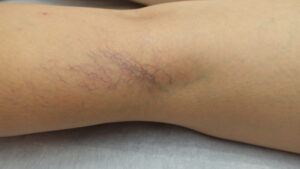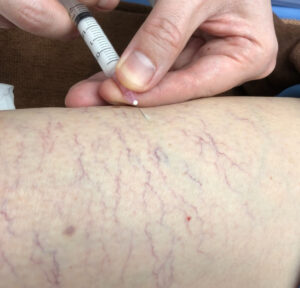Why Winter Is the Best Season for Spider Vein Treatment — Recommended Timing and Treatment Flow
Thin red to purple veins spreading across the calves or thighs are known as spider veins (telangiectasia). For many women, they are a cosmetic concern — but did you know that winter is actually the ideal season to begin treatment? In this article, we explain from a medical perspective why winter treatment makes sense, the treatment methods, and what to expect after the procedure.

Spider veins
Five Reasons to Start Treatment in Winter
- Compression stockings are more comfortable to wear: After treatment, patients are advised to wear compression stockings for a certain period. During the colder months, discomfort such as sweating or heat is minimal, making it easier to comply with instructions.
- Easier UV protection: Avoiding ultraviolet light is important to reduce the risk of pigmentation. In winter, sunlight is weaker and skin exposure is minimal, which makes aftercare much easier.
- Bruising and redness are easier to hide: Tights, long skirts, or pants naturally cover the treated areas.
- Allows for planned multiple sessions: Spider vein treatment often requires 2–3 sessions spaced several weeks apart. Starting in winter helps you complete the series in time for spring or early summer.
Seasonal Comfort Comparison After Treatment
| Point | Winter | Summer |
|---|---|---|
| Comfort with compression stockings | ◎ Less sweating | △ More sweating and itching |
| Ease of UV protection | ◎ Less exposure, easier care | △ Strong sunlight, more protection needed |
| Covering bruises/redness | ◎ Easy with clothing | △ More leg exposure |
| Scheduling multiple treatments | ◎ Easy to complete by spring | △ Hard to achieve visible results quickly |
Main Treatment Method
Sclerotherapy
This is the most common and effective method for spider veins. A fine needle is used to inject a foamed sclerosant into the vein, causing it to close and shrink from the inside. The procedure time varies depending on the size and area treated but usually takes only a short time on an outpatient basis. After treatment, compression stockings are worn to help seal the veins.

Sclerotherapy
Treatment Flow
- Consultation and evaluation: In addition to visual and physical examination, ultrasound is used to assess venous blood flow in the legs and confirm eligibility for sclerotherapy.
- Procedure: The treatment takes about a few minutes to 15 minutes depending on the extent. Pain is minimal, and the use of very fine needles helps reduce discomfort.
- Compression: Immediately after the procedure, compression with stockings is started and continued for about one month.
- Follow-up: Re-evaluation is performed every 2–4 weeks, and additional sessions are conducted if necessary.
Downtime and Recovery
- Bruising or redness: Usually subsides within a few days to two weeks.
- Pigmentation: Temporary pigmentation may appear but typically fades within a few months to six months.
- Results: About half of the treated spider veins disappear within 1–3 months after one session. For those with widespread spider veins, multiple treatments will gradually improve the appearance.
Post-Treatment Care (Important Even in Winter)
- Wear the prescribed compression stockings as instructed (usually for about one month).
- UV protection: Even in winter, UV rays are not zero. Protect your legs with stockings or long bottoms when going outside.
Frequently Asked Questions (FAQ)
- Q. Can I finish treatment in one session?
- A. It depends on the number and area of spider veins. Typically, about half of them disappear after one session. Therefore, 2–3 sessions are recommended. Starting in winter helps you complete treatment before spring and summer when legs are more exposed.
- Q. How painful is it?
- A. You may feel a slight prick during the injection, but the needle used for sclerotherapy is even thinner than those used for vaccine injections. Among over 3,000 patients treated so far, only two found the injection pain intolerable.
- Q. Will it come back?
- A. The treated veins will close permanently, but new veins may appear over time due to genetic factors, hormones, or lifestyle. In such cases, retreatment is possible.
- Q. I’m worried about pigmentation.
- A. While there are individual differences, it generally fades over time.
Start in Winter, Show Off Your Legs in Spring
By starting spider vein treatment in winter, you can enjoy multiple advantages such as easier compression, better UV protection, and less visible bruising. For those who need several sessions, winter treatment ensures you’ll have smooth and confident legs by spring or early summer.
Clinic Information (Megurogeka | The Varicose Vein Clinic TOKYO)
- During consultation, ultrasound examination is performed if necessary to evaluate for deeper venous reflux.
- Treatment for spider veins is generally not covered by insurance and considered an elective cosmetic procedure. We will explain costs, number of sessions, and recovery time clearly in advance.
Book your consultation today. Whether you have widespread spider veins or are concerned about pigmentation, please feel free to contact us for professional advice.


